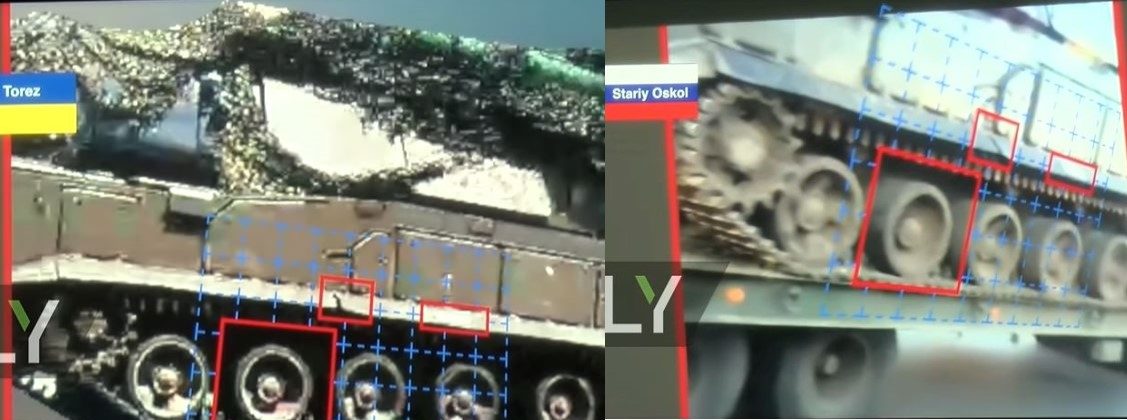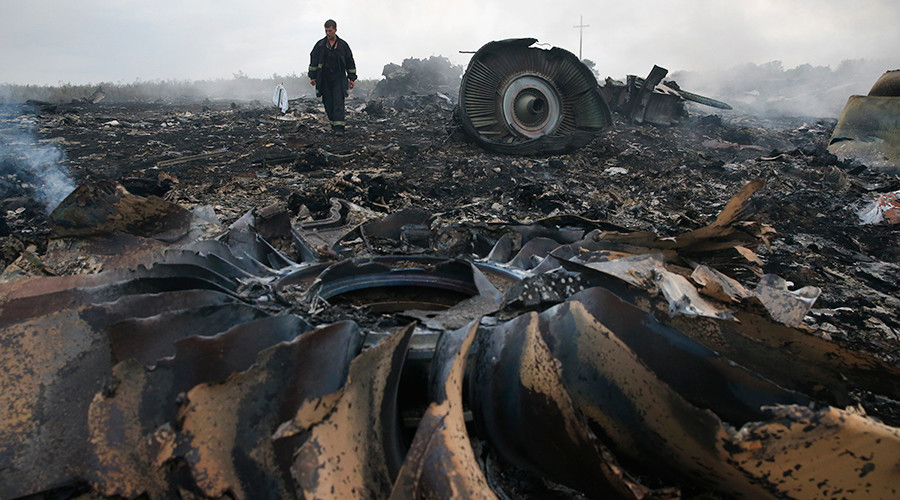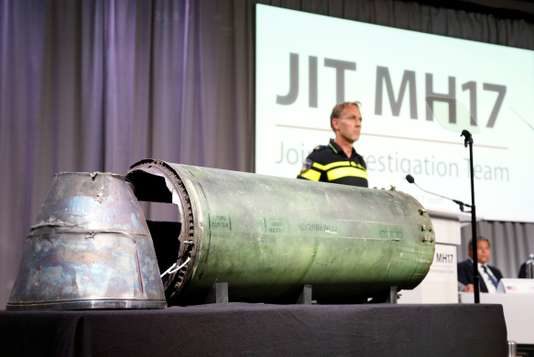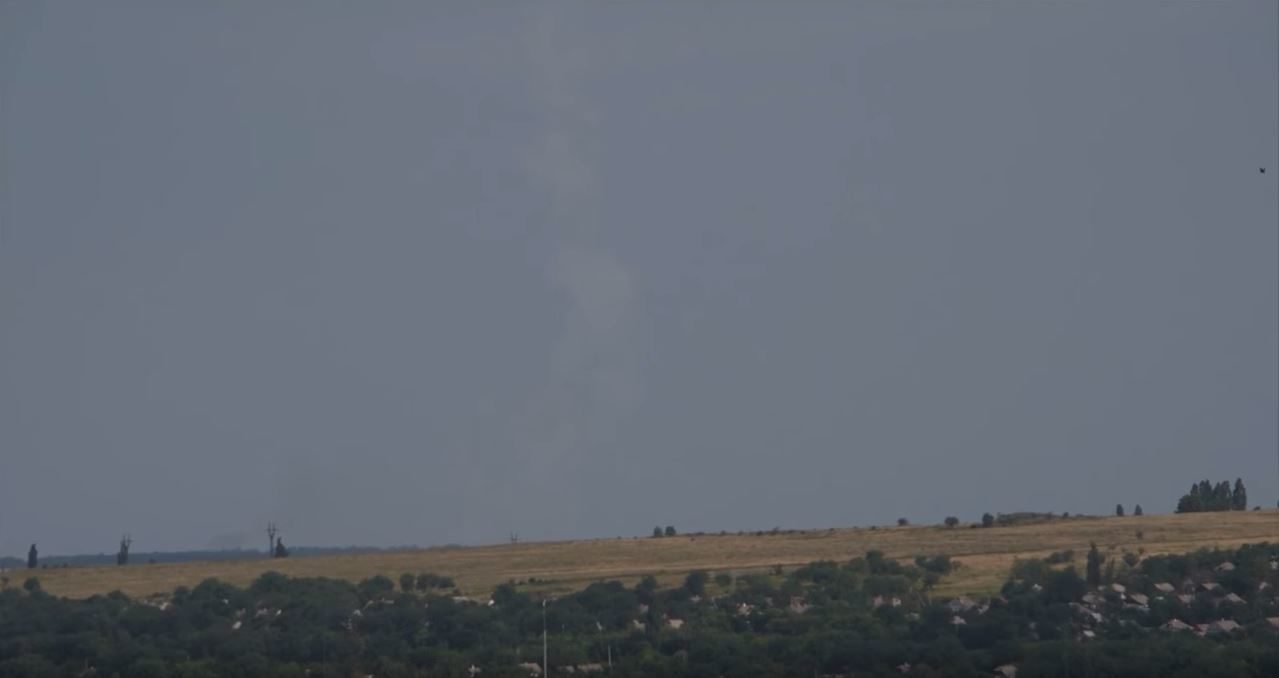They made two central claims:
- That a BUK-TELAR Russian unit from the 53rd brigade based in Kursk crossed the border into Ukraine, and
- That the markings on the remains of the BUK missile allegedly used in the incident indicate it was Soviet made.
Spot The Similarity
The evidence presented at the JIT press conference was based on photographs and videos from Google maps and social media images. By matching casual videos of a passing Russian military convoy within Russia with Google maps land features, JIT claim they could track six BUK-TELAR vehicles leaving a Kursk base on the 23rd of June and somewhat approaching the Ukranian border. The last image of the convoy on the Russian side was taken on the 25th of June (almost a full month before the MH17 incident). Further images and videos of a single BUK-TELAR on the Ukranian side being carried by a different truck on the day of the crash, 17th of July, and the following day, are used as evidence that this one unit made it across the border, and it is assumed to be the one that made the killer shot.
In order to establish that this is indeed one of the Russian BUK-TELAR units and not a Ukranian one, the JIT engages in an argument about the 'fingerprint' of the unit on the Ukranian side which, it claims, matches one of the Russian ones. Since the photographs were taken by casual passersby with mobile phone cameras, the resolution is not very high - not to mention the ease with which these images and videos could have been manipulated, as explained here. Reaching definite conclusions based on these is as speculative as you would expect from an armchair conspiracy theorist such as Bellingcat's Elliot Higgins.
The 'fingerprint' refers to things like the position of the markings on the tank and the type of wheels - whether with spokes or without them - and other small features and spots on the machine.


As for the second assertion - that the remains of the BUK missile point to its Soviet/Russian origin - nothing is said about how or where this missile was recovered. By their own admission, the JIT investigation team had no access to the area of the incident yet [13:15 on the press conference video], so we can only assume that this important piece of evidence was kindly handed to them by Kiev, which is playing the role of both investigator and potentially suspect party - unlike Russia, which was barred from taking any part in the investigation at all.
It is also claimed that the markings show the missile was made in 1986. This is significant because, according to the Russian BUK producer Almaz-Antey, the particles which hit the plane are indeed consistent with a model of BUK missile last produced in the Soviet Union in 1986. However, its lifespan is 25 years, including all prolongations, and it was decommissioned from the Russian Army in 2011. Ukraine had access to the same military equipment, so the Russian manufacturing of the weapon proves nothing about Russia's culpability.
The Weakest Link
In September 2016, the JIT had already presented a similar Google maps and social media treasure hunt of the alleged BUK-TELAR, but on the Ukrainian side. The vehicle is shown parading around on a white truck with a red trailer, across the border, all the way to Donetsk and back again to the Luhansk area, accompanied by a single SUV and a military jeep, where it finally settled in a field not far from the towns of Snizhne and Pervomaiskiy, 21 kms south-east of the crash site of MH-17. The final available video, however, is in Snizhne itself - not on the field. (You can see an image analysis of the video here, arguing that it was in fact faked.) Russia has contradicted the JIT by pointing out that its radar detected no airborne targets approaching the passenger plane from the eastern side, "including from the direction of Snezhnoye [Shnizhne] or Pervomayskoye[Pervomaiskiy]".
The important link in the JIT's (and Bellingcat's) argumentation is whether that BUK vehicle was indeed the one that shot down Flight MH-17. Otherwise, all the fancy animations and chasing around the countryside after that particular vehicle are irrelevant. On this point the JIT has "statements of many witnesses" of a launch and of journalists who saw a scorched field. Unfortunately, no witnesses or journalists are named, nor are their statements reproduced and, therefore, this link is the weakest. Apart from that, there are some mobile phone conversations that could have been easily taken out of context to make them match the hypothesis, as well as a couple of pictures faintly showing what could be the dissipating trail of the missile, and a satellite image of the 21st of July showing a partially burned field. Did it not occur to the JIT investigators that the fire on the field could have caused the smoke itself without any need for a missile launch site to explain it?
Here are two videos of BUK missile launches for you to decide if the picture above is a missile trail or not.
On the other hand, there are witnesses to the crash of Flight MH-17. Some of them were in Snezhnoye and they spoke to the cameras, including those of the BBC. They said nothing of a BUK missile or missile trail - in fact, some explicitly denied that - and instead they spoke of fighter jets. Some claim that one of the jets shot the plane. The rebels have no air force, so the jets had to belong to Kiev.
There is also an alleged Ukrainian whistleblower who claims that a Ukrainian pilot, captain Vladislav Voloshin, accidentally shot down the airplane. Shouldn't the JIT pursue this line of inquiry at least as vigorously as it tracks a BUK-TELAR across the countryside? Is the reason that the fighter jets are not even mentioned by the JIT the same reason the BBC chose to delete their above video report - that is, that the investigation began with the conclusion that 'Russia did it', instead of letting the facts lead it one way or the other?
Why Now?
Since its last installment in September 2016, the JIT had more than a year and a half to put together the presentation we saw on Thursday. Bellingcat had already covered most of the points presented by JIT, so why did it take them so long to present them? Why did they choose this particular moment to make the headlines by openly blaming Russia? There are three possible reasons:
- This was an attempt to attack Russia's image during the St Petersburg International Economic Forum, in which French president Emmanuel Macron was a guest of honour. France has agreed to several investment projects in cooperation with Russian firms.
- The Football World Cup begins in a couple of weeks in Russia. The idea would be to 'rain on the party' and spoil Russia's opportunity to improve their image on the world stage. It would be in Russia's best interest for the global situation to be as stable as possible during the World Cup, which means that the enemies of Russia will take the opportunity to cause as much trouble as possible. This leads to the next point.
- The conflict in eastern Ukraine may be about to escalate. Last week, Kiev forces advanced on Donetsk People's Republic's positions north of the city of Gorlovka. The clashes included the Kiev artillery shelling civilian areas in settlements around Gorlovka and in the city itself, resulting in civilian casualties and the destruction of civilian infrastructure. Locals also report that Kiev has amassed troops, military equipment and tanks in the area of Stanytsia Luganskaya, north of Lugansk.






Reader Comments